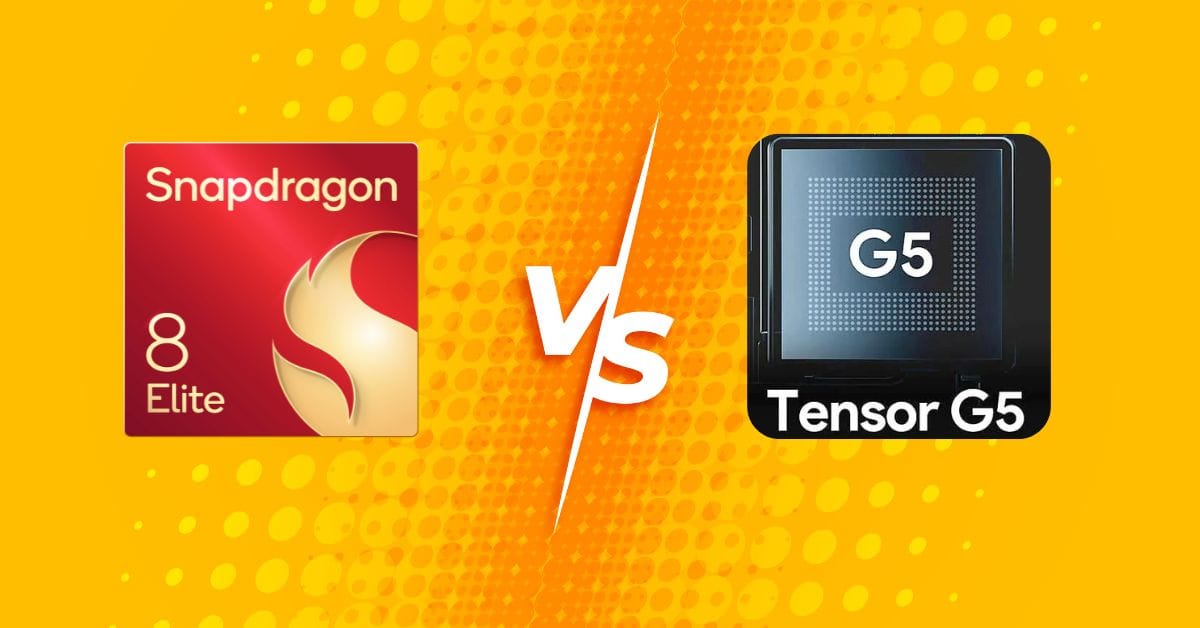- Process and core design differences: Snapdragon 8 Elite’s custom Oryon cores on TSMC’s 3nm process run faster than Tensor G5’s standard Arm Cortex cores, boosting overall performance.
- Benchmark results favor Snapdragon: Geekbench and AnTuTu scores show Snapdragon 8 Elite is up to 39% faster in CPU tests and nearly doubles Tensor G5’s GPU strength.
- Gaming advantage with Adreno 830: Snapdragon’s Adreno 830 GPU delivers ray tracing, higher FPS, and smoother 3D performance compared to Tensor G5’s PowerVR graphics chip.
- Connectivity and modem support: Snapdragon’s X80 modem provides faster speeds, better reliability, and UWB support, while Tensor G5’s Samsung Exynos modem falls behind in coverage.
- AI focus vs performance edge: Tensor G5 prioritizes AI and camera processing for Pixel phones, while Snapdragon 8 Elite dominates heavy multitasking, gaming, and performance-driven use cases.
For years, Google’s Tensor chips have been criticized for falling behind Qualcomm’s Snapdragon and Apple’s A-series processors. Pixel phones nailed AI and cameras, but stumbled in raw power. With the Tensor G5 built on TSMC’s 3nm process, many hoped Google would finally close the gap. But does it actually match Qualcomm’s Snapdragon 8 Elite?
The short answer is no. The long answer is a little more nuanced. Tensor G5 is a big upgrade for Google, but Qualcomm still dominates in raw performance.
Table of Contents
- Tensor G5 vs Snapdragon 8 Elite: Specs Comparison
- Snapdragon 8 Elite vs Tensor G5: Geekbench 6 Results
- Tensor G5 vs Snapdragon 8 Elite: AnTuTu Performance
- Snapdragon 8 Elite vs Tensor G5: 3DMark & Gaming Tests
- Tensor G5 vs Snapdragon 8 Elite: Head-to-Head
- Real-World Experience
- Phones Using These Chips
- Verdict: Which One Should You Pick?
Tensor G5 vs Snapdragon 8 Elite: Specs Comparison
Both chips are made on TSMC’s 3nm (N3E) process, but the designs are very different.
| Feature | Tensor G5 | Snapdragon 8 Elite |
|---|---|---|
| Process | Built on TSMC’s 3nm (N3E) | Same TSMC 3nm (N3E) process |
| CPU | 8-core design using Arm Cortex cores | 8-core design with Qualcomm’s 2nd-gen Oryon cores |
| CPU Layout | 1× Cortex-X4 @ 3.78GHz5× Cortex-A725 @ 3.05GHz2× Cortex-A520 @ 2.25GHz | 2× Oryon @ 4.32GHz6× Oryon @ 3.53GHz |
| GPU | PowerVR DXT-48-1536, no ray tracing | Adreno 830 with ray tracing & Elite Gaming |
| Memory & Storage | UFS 4.0 + LPDDR5X | UFS 4.0 + LPDDR5X up to 5.3GHz, 10.7Gbps bandwidth |
| AI Engine | Google’s new Edge TPU for on-device AI | Qualcomm Hexagon NPU with multimodal AI support |
| ISP | New Google ISP, 4K video at 60FPS | AI Spectra ISP, 320MP photos, 8K HDR video at 60FPS |
| Modem | Samsung Exynos 5400, Sub-6GHz 5G (India) | Snapdragon X80, up to 10Gbps download, 3.5Gbps upload |
| Connectivity | Wi-Fi 6E/7, Bluetooth 6.0 | Wi-Fi 7, Bluetooth 6.0, and UWB |
Snapdragon 8 Elite vs Tensor G5: Geekbench 6 Results
Here are the leaked Geekbench 6 CPU results comparing the two chips side by side. They highlight just how much more powerful Snapdragon’s custom Oryon cores are compared to Google’s Arm-based design.
| Geekbench 6 | Tensor G5 | Snapdragon 8 Elite (Gen 4) |
|---|---|---|
| Single-core | 2,301 | 3,155 (+37%) |
| Multi-core | 6,987 | 9,723 (+39%) |
Looking at the table, Snapdragon 8 Elite scores 3,155 in single-core and 9,723 in multi-core, compared to Tensor G5’s 2,301 and 6,987. That means Snapdragon delivers roughly 37% stronger single-core and 39% stronger multi-core performance. The Oryon cores clearly put Qualcomm ahead, leaving Google’s Arm-based design struggling to keep up.
Tensor G5 vs Snapdragon 8 Elite: AnTuTu Performance
Here are the latest AnTuTu v10 results. They show Snapdragon pulling far ahead of Tensor not just in total score but across CPU, GPU, memory, and UX.
| AnTuTu v10 | Tensor G5 | Snapdragon 8 Elite (Gen 4) |
|---|---|---|
| Total Score | 1,508,196 | 2,734,385 (+81%) |
| CPU | 497,292 | 589,887 |
| GPU | 553,638 | 1,222,566 |
| Memory | 222,069 | 460,012 |
| UX | 265,772 | 461,920 |
| Samples | Less than 3 | 225 tests |
The difference is staggering. Snapdragon 8 Elite (Gen 4) posts a total AnTuTu v10 score of 2,734,385, compared to Tensor G5’s 1,508,196. CPU is about 19% higher (589,887 vs 497,292), GPU nearly doubles (1.22M vs 553K), and memory/UX are also well ahead. That translates to smoother gaming, faster multitasking, and a more responsive system overall on Snapdragon-powered phones.
Snapdragon 8 Elite vs Tensor G5: 3DMark & Gaming Tests
In 3DMark Wild Life, Snapdragon posts 23,528 points. Tensor G5 results are either unavailable or much lower. Qualcomm’s Adreno 830 GPU not only supports ray tracing but also pushes higher FPS in demanding games. The PowerVR GPU in Tensor G5 simply can’t keep up. While we do not have exact numbers for Tensor as of now, we can still conclude Tensor lacks here too.
Tensor G5 vs Snapdragon 8 Elite: Head-to-Head
Here, we break things down feature by feature. From CPU design to connectivity, each part shows why Snapdragon pulls ahead and where Tensor tries to compensate with AI and efficiency.
CPU Architecture
Snapdragon 8 Elite uses Qualcomm’s custom second‑gen Oryon cores, clocked up to 4.32GHz on performance cores and 3.53GHz on efficiency cores. This design delivers far better single‑core results and nearly 50% stronger multi‑core performance in Geekbench.
Tensor G5 relies on off‑the‑shelf Arm Cortex designs, one Cortex‑X4 at 3.78GHz, five Cortex‑A725 at 3.05GHz, and two Cortex‑A520 at 2.25GHz. While efficient, it lags well behind in raw computing power.
GPU
Qualcomm’s Adreno 830 GPU is on another level, offering higher frequency (~1100MHz), support for ray tracing, and Elite Gaming features. It scores almost three times higher in AnTuTu GPU tests and dominates 3DMark with 23,528 points. Tensor G5’s PowerVR DXT‑48‑1536 GPU lacks ray tracing, runs at ~1000MHz, and falls far short in demanding gaming benchmarks.
Memory & Storage
Both chips support LPDDR5X RAM and UFS 4.0 storage, but Snapdragon can push memory up to 5.3GHz with bandwidth as high as 10.7Gbps. Tensor G5 supports LPDDR5X but tops out lower, and in AnTuTu memory tests, it trails heavily (222K vs 460K). Snapdragon also supports UFS 4.1 for even faster storage speeds.
AI & NPU
Google equips Tensor G5 with a new Edge TPU to power Pixel‑exclusive AI features like on‑device photo enhancements, voice processing, and live translation. Snapdragon’s Hexagon NPU is more versatile, handling multimodal AI, text, images, and audio, with broader support across Android OEMs. Qualcomm’s AI engine also shows higher raw throughput, though Pixel software may feel smarter thanks to Google’s integration.
ISP & Cameras
Tensor G5 has a new ISP tuned for real‑time semantic segmentation and computational photography, enabling Pixel’s signature camera tricks. It can shoot up to 8K at 30FPS and 4K at 120FPS. Snapdragon’s Spectra ISP goes further, supporting 320MP photos, limitless segmentation, and 8K HDR video at 60FPS. For camera hardware flexibility, Snapdragon wins, but Pixel still leverages software to stay competitive.
Connectivity
Tensor relies on Samsung’s Exynos 5400 5G modem, limited to sub‑6GHz bands in India. It supports Wi‑Fi 7 and Bluetooth 6.0 but lacks Ultra Wideband. Snapdragon’s X80 modem reaches up to 10Gbps downloads and 3.5Gbps uploads, supports Wi‑Fi 7 with 5.8Gbps peak speeds, Bluetooth 6.0, and UWB — giving it more reliable coverage and faster real‑world speeds.
Efficiency & Battery Life
According to NanoReview, Snapdragon gets a slight edge here, scoring 93 for efficiency compared to Tensor’s 91. It can hold peak performance longer without slowing down.
Tensor G5, on the other hand, seems to be more efficient at lower power levels (around 3W), which could mean better battery life during light everyday use. Google’s design with seven mid/efficiency cores may help Pixels last longer in normal use, but when it comes to gaming or heavy work, Snapdragon still pulls ahead.
Real-World Experience
On paper, Snapdragon wins everywhere. But Pixels have always been more about software-first experiences. Tensor G5 unlocks smarter AI features, faster image processing, and Google’s camera magic. For daily use, it may feel smooth enough, but power users, gamers, and those who need longevity under heavy load will notice Snapdragon’s lead.
Reddit users echo this sentiment. Many Pixel fans are fine with Tensor’s performance for everyday tasks, but frustrated that $1000+ phones still use chips that can’t compete with cheaper Snapdragon-powered devices. The biggest criticism? Google keeps raising Pixel prices while shipping midrange-level silicon.
Phones Using These Chips
When comparing these two chipsets, it’s also important to look at the phones they actually power. This shows how each company positions its hardware in the market.
Tensor G5 devices
Google’s latest Pixel 10 lineup runs exclusively on Tensor G5. The devices include:
- Pixel 10
- Pixel 10 Pro
- Pixel 10 Pro XL
- Pixel 10 Pro Fold
All of these phones lean heavily on Google’s AI features, advanced photography, and tight integration between hardware and software.
Want to dive deeper into Google’s new magnetic charging ecosystem? Check out our full guide: Everything You Need to Know About Google Pixelsnap.
Snapdragon 8 Elite devices
Qualcomm’s flagship chip is used across many premium brands, including:
- Galaxy S25 series (S25, S25+, S25 Ultra)
- Xiaomi 15 Ultra
- OnePlus 13
- ASUS ROG Phone 9 Pro (gaming-focused)
- iQOO 13
- Vivo X200 Ultra
- And many more
These phones are built for raw power, gaming, and cutting-edge connectivity, showcasing Snapdragon’s strength in the wider Android ecosystem.
Verdict: Which One Should You Pick?
If you want raw performance, gaming power, and future-proof connectivity, Snapdragon 8 Elite is untouchable. It’s nearly twice as fast in benchmarks and packs features Tensor can’t match.
If you value AI features, Pixel-exclusive software tricks, and Google’s camera optimizations, Tensor G5 delivers a solid experience despite weaker numbers. It’s the best Tensor yet, just not enough to dethrone Qualcomm.
In the end, Google is still catching up. Tensor G5 narrows the gap slightly, but Snapdragon 8 Elite remains in a league of its own.









